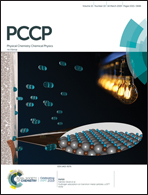Shear heating, flow, and friction of confined molecular fluids at high pressure†
Abstract
Understanding the molecular-scale behavior of fluids confined and sheared between solid surfaces is important for many applications, particularly tribology where this often governs the macroscopic frictional response. In this study, nonequilibrium molecular dynamics simulations are performed to investigate the effects of fluid and surface properties on the spatially resolved temperature and flow profiles, as well as friction. The severe pressure and shear rate conditions studied are representative of the elastohydrodynamic lubrication regime. In agreement with tribology experiments, flexible lubricant molecules give low friction, which increases linearly with logarithmic shear rate, while bulky traction fluids show higher friction, but a weaker shear rate dependence. Compared to lubricants, traction fluids show more significant shear heating and stronger shear localization. Models developed for macroscopic systems can be used to describe both the spatially resolved temperature profile shape and the mean film temperature rise. The thermal conductivity of the fluids increases with pressure and is significantly higher for lubricants compared to traction fluids, in agreement with experimental results. In a subset of simulations, the efficiency of the thermostat in one of the surfaces is reduced to represent surfaces with lower thermal conductivity. For these unsymmetrical systems, the flow and the temperature profiles become strongly asymmetric and some thermal slip can occur at the solid–fluid interface, despite the absence of velocity slip. The larger temperature rises and steeper velocity gradients in these cases lead to large reductions in friction, particularly at high pressure and shear rate.



 Please wait while we load your content...
Please wait while we load your content...